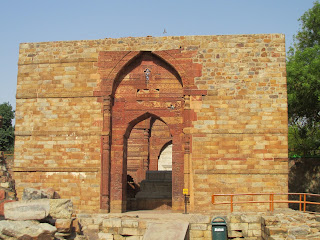Iltutmish's Tomb - Qutb Complex, Delhi
Delhi, the vibrant capital of India, is renowned for its rich array of historical monuments, boasting approximately 1300 scattered across its landscape. Among these, the iconic Qutb Minar stands tall as a favorite among visitors. Within the expansive Qutb Minar complex, housing not only the famed minaret but also numerous other historical gems, lies the significant site of Iltutmish's tomb.

Upon Qutbud-Din's death, his son-in-law Shamsud-Din-Iltutmish succeeded him in 1211 CE. Iltutmish made significant contributions to the Qutb Minar and Quwwat mosque, initiated by Qutbud-Din. He also erected the tomb for his eldest son, Nasirud-Din, known as Sultan Ghari's tomb, in 1231 CE. It is the earliest existing monumental Muslim tomb. (There are some pre-Sultanate tombs found in Kutch area in Gujarat which were constructed with the materials from the demolished Hindu temples). In 1235 CE, Iltutmish built his own tomb within the Qutb complex, showcasing remarkable advancements in Indo-Islamic architecture.

Historical Background
Rai Pithora, also known as Prithviraj Chauhan III, expanded the Lal Kot by constructing a fort named Qila Rai Pithora while ruling Delhi. Muhammad bin Sam of Ghur invaded Qila Rai Pithora, defeating Prithviraj in his second attempt and capturing the fort. Qutbud-Din Aibak, his slave, was appointed the Viceroy of Delhi and later ascended to the throne as the Sultan of Delhi in 1206 CE, marking the beginning of the slave dynasty's rule.
Upon Qutbud-Din's death, his son-in-law Shamsud-Din-Iltutmish succeeded him in 1211 CE. Iltutmish made significant contributions to the Qutb Minar and Quwwat mosque, initiated by Qutbud-Din. He also erected the tomb for his eldest son, Nasirud-Din, known as Sultan Ghari's tomb, in 1231 CE. It is the earliest existing monumental Muslim tomb. (There are some pre-Sultanate tombs found in Kutch area in Gujarat which were constructed with the materials from the demolished Hindu temples). In 1235 CE, Iltutmish built his own tomb within the Qutb complex, showcasing remarkable advancements in Indo-Islamic architecture.
Iltutmish's Tomb
Situated to the north-west of the Quwwatul-Islam mosque, Iltutmish's tomb, completed in 1235 CE, is a testament to the evolution of Indo-Islamic architectural practices. Unlike previous tombs constructed using materials from demolished Hindu temples or Jain shrines, Iltutmish's tomb stands out as it was built entirely from quarried materials, marking a departure from the prevalent practice.
While its exterior appears simple, the interior of the tomb is adorned with intricate geometric patterns and delicate calligraphy. Originally featuring a dome, it was later replaced with another dome by Firuz Shah Tughlaq. However, the current structure lacks a dome, leaving the interior open.
The marble cenotaph of Iltutmish rests on a raised platform, with his actual remains housed in underground chambers. Three mihrabs adorn the west side, with three entrances in other directions. The central marble mihrab is elevated, while the two red sandstone mihrabs are framed by arched entrances.
Inscriptions in Kufi and Naskh characters, along with geometric patterns, adorn both entrances and interiors. Incorporating Hindu traditional designs like diamonds, wheels, and lotuses, the tomb reflects a harmonious fusion of artistic influences. Noteworthy is the architectural ingenuity demonstrated in incorporating small arches to transform the square chamber into an octagonal structure, facilitating the placement of the dome.
As you explore this historical marvel, delve into the intricate details of Iltutmish's tomb—a testament to the cultural confluence that defines Delhi's architectural heritage.
Happy travelling.








.JPG)
Comments
Post a Comment